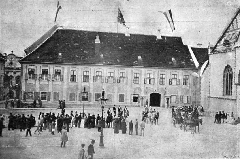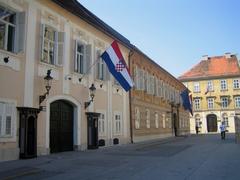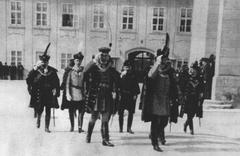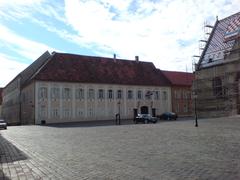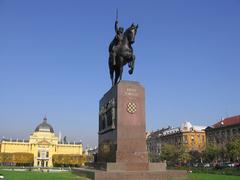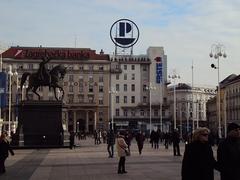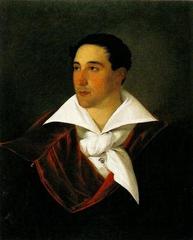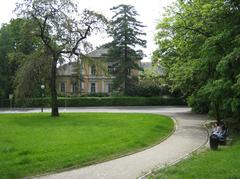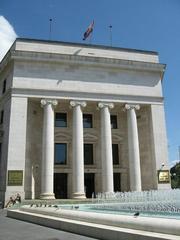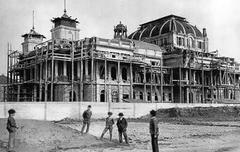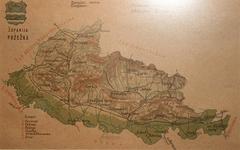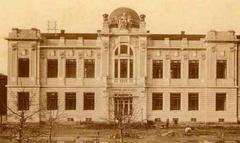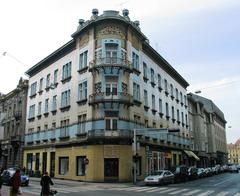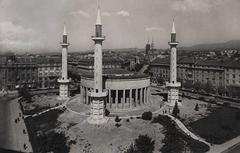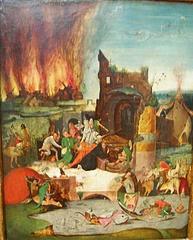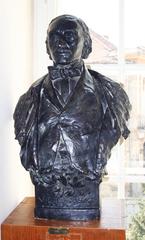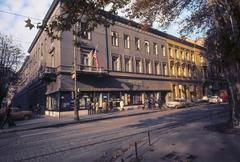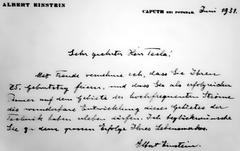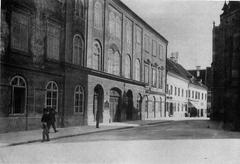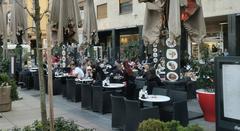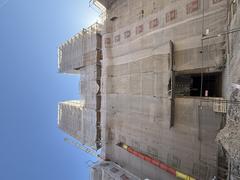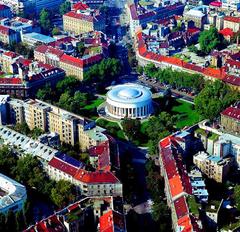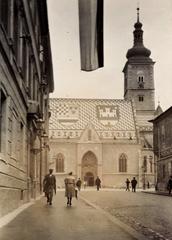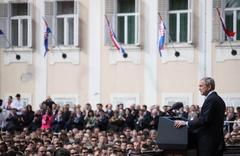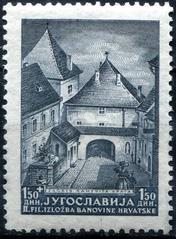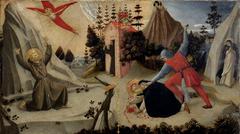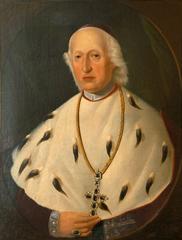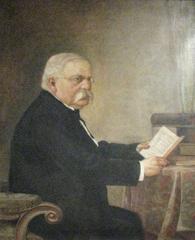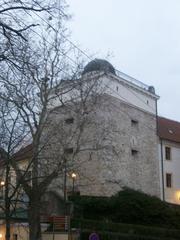
Banski Dvori Zagreb: Visiting Hours, Tickets, and Historical Significance
Date: 14/06/2025
Introduction
Banski Dvori is one of Zagreb’s most iconic landmarks—an architectural and political symbol of Croatia. Located on St. Mark’s Square in the city’s historic Upper Town, this Baroque palace has played a central role in the country’s governance and history, serving as the seat of the Croatian Government. While Banski Dvori is typically closed to the public due to its function as a working government building, its stately exterior, historical importance, and proximity to other major attractions make it an essential stop for visitors to Zagreb.
This comprehensive guide details the origins, architectural evolution, political significance, and visitor logistics for Banski Dvori. It also offers practical travel tips and highlights nearby points of interest to ensure you get the most out of your visit. For those interested in broader regional architecture, the guide also distinguishes between Zagreb’s Banski Dvori and Banja Luka’s Banski Dvor, a culturally significant building in Bosnia and Herzegovina.
For the latest updates, always refer to official resources and local tourism platforms before your visit. (Wikipedia; Lice Grada; Vlada.gov.hr; Visit Croatia)
History and Significance
Origins and Early Development
Banski Dvori stands on the site of a 17th-century noble residence once owned by Count Petar Zrinski. After the 1671 Magnate conspiracy, ownership passed through several aristocratic families, including the Čikulini, Sermage, and Kulmer families. In the late 18th century, Count Sermage initiated the construction of a grand Baroque palace, integrating older medieval buildings such as an armory and St. Ursula’s Chapel (Wikipedia; Lice Grada). Ivan Kulmer later expanded the structure, shaping the palace as it is known today.
Architectural Evolution
Banski Dvori is a prime example of Baroque Classicism. Major construction began in 1801 and was completed after government acquisition in 1808. Architect Ivan Eyther transformed the palace into the official seat of the Croatian Ban by 1811, with further enhancements by Ludwig Berger in 1837 (Wikipedia; Vlada.gov.hr). Ban Ivan Mažuranić oversaw significant upgrades in the late 19th century, and the palace’s overall structure has remained largely unchanged since then.
Political Role in Croatian History
From 1809 to 1918, Banski Dvori was the executive hub of Croatian governance, housing both the Ban and significant government institutions. It was the scene of historical milestones, such as Ivan Kukuljević Sakcinski’s famed 1843 speech advocating for the Croatian language (Vlada.gov.hr). Through the 20th century, it adapted to new political realities, serving as the government seat for different regimes, including the Independent State of Croatia during WWII and the Yugoslav Socialist Republic of Croatia (Wikipedia).
Modern Era and Restoration
Since Croatia’s independence and the advent of a multiparty system in 1990, Banski Dvori has been the exclusive seat of the Croatian Government. In 1991, it was targeted and damaged in an airstrike during the Croatian War of Independence, a pivotal event in the nation’s modern history (Wikiwand; Cultura Obscura). Subsequent restoration preserved its historical integrity, and today it remains a protected cultural monument (Wikipedia).
Visitor Information
Location and Accessibility
Banski Dvori is located at Trg sv. Marka 1, on St. Mark’s Square in Zagreb’s Upper Town (Wikipedia; Lice Grada). The surrounding area is pedestrian-friendly, with cobblestone streets and limited vehicle access. The closest tram stops are at Ban Jelačić Square, a 10–15 minute uphill walk, or you can take the historic funicular for easier access (Visit Croatia).
Visiting Hours and Tickets
Public Access:
Banski Dvori is generally not open for interior tours. The palace can be admired from the outside at any time, as St. Mark’s Square is open 24/7. No tickets are required for viewing the exterior (Wikipedia).
Special Events:
Occasionally, limited public access is granted during government open days or national celebrations. Such events are announced in advance on official websites—check these regularly if you hope to see the interior.
Guided Tours
While the building itself is closed, guided walking tours of Zagreb’s Upper Town often include historical commentary on Banski Dvori from the exterior and visits to nearby attractions (TourHQ; GPSmyCity).
Accessibility
Upper Town’s cobblestones and slopes can be challenging for some visitors. St. Mark’s Square is relatively flat, but the approach from Lower Town involves some uphill walking or funicular use. As the palace is not open to visitors, there are no designated accessibility facilities at Banski Dvori (Visit Croatia).
Security and Etiquette
Banski Dvori is under constant security due to its status as a government building. Photography of the exterior is generally allowed, but avoid capturing security personnel or installations. Respect official barriers and maintain decorum, especially during government functions or special events.
What to See and Do Around Banski Dvori
- St. Mark’s Church: Famous for its colorful roof, located directly opposite Banski Dvori (Visit Croatia).
- Croatian Parliament (Sabor): Situated on the eastern side of St. Mark’s Square.
- Stone Gate (Kamenita vrata): The only surviving medieval city gate.
- Lotrščak Tower: Offers panoramic city views and the daily noon cannon shot.
- Museum of Broken Relationships: A unique museum nearby.
Special Event:
From mid-April to October, the Changing of the Guard by the Honorary Cravat Regiment takes place at noon on weekends and holidays—an excellent photo opportunity with Banski Dvori as a backdrop (Croatia.hr).
Practical Tips
- Footwear: Wear comfortable shoes for walking on cobblestones (Travel Lemming).
- Weather: Spring and autumn offer the most pleasant conditions for walking tours (Wanderlog).
- Language: English is widely spoken in tourist areas, but learning a few Croatian phrases is appreciated.
- Currency: Croatia uses the euro (EUR). Carry small denominations for local vendors.
- Facilities: No restrooms or cafes at Banski Dvori; amenities can be found nearby in Lower Town or Tkalčićeva Street.
Banski Dvor (Banja Luka) – Not to Be Confused
While researching, you might encounter references to Banski Dvor in Banja Luka, Bosnia and Herzegovina, which is a different building altogether. This structure, completed in 1932, showcases Byzantine-Serbian architectural style and currently serves as a cultural center hosting concerts, exhibitions, and public events (banjaluka.city). If your travels extend to Banja Luka, consider a visit to appreciate the regional diversity in architectural heritage.
Frequently Asked Questions (FAQ)
Q: Can I tour the inside of Banski Dvori?
A: The building is not open to the public, except for rare open days or special events.
Q: Are tickets required?
A: No tickets are needed for admiring the exterior.
Q: What’s the best way to reach Banski Dvori?
A: On foot from Ban Jelačić Square or via the funicular; the area is pedestrian-friendly.
Q: When is the Changing of the Guard ceremony?
A: Weekends and public holidays at noon, from mid-April to October.
Q: Is the area accessible for visitors with disabilities?
A: Access may be challenging due to cobblestone streets and slopes; the funicular provides step-free access, but Banski Dvori itself has no visitor amenities.
Summary Table: Key Practical Information
| Aspect | Details |
|---|---|
| Location | Trg sv. Marka 1, Upper Town, Zagreb |
| Access | Exterior view only; no public interior tours |
| Opening Hours | St. Mark’s Square open 24/7 |
| Tickets | Not required |
| Security | High; respectful behavior required |
| Guided Tours | Included in many Upper Town walking tours |
| Special Events | Changing of the Guard (mid-April–October, weekends and select holidays) |
| Facilities | None at Banski Dvori; cafes and restrooms nearby |
| Accessibility | Limited by cobblestones and slopes; funicular access from Lower Town |
| Nearby Attractions | St. Mark’s Church, Parliament, Stone Gate, Lotrščak Tower, Museum of Broken Relationships |
Conclusion & Recommendations
Banski Dvori is a central piece of Croatia’s political and architectural heritage. While interior visits are generally off-limits, its striking Baroque façade, historical resonance, and location amid other Upper Town landmarks make it an essential stop on any Zagreb itinerary. For deeper insights, join a guided walking tour or use the Audiala app for audio commentary. To ensure the best experience, consult official tourism resources for event updates and access information.
For more details:
- Banski Dvori, Wikipedia
- Povijest zgrade Banskih dvora, Lice Grada
- Banski Dvori, Vlada Republike Hrvatske
- Sightseeing in Zagreb, Visit Croatia
- Banski Dvor, Banja Luka City
- Bombing of the Banski Dvori, Wikiwand
- Dark Tourism in Zagreb, Cultura Obscura
For the latest travel tips, event details, and walking tour recommendations, download the Audiala app and follow us across social media.
